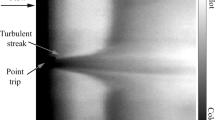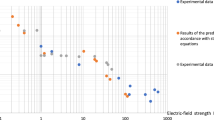Abstract
Inevitable errors in X-probe measurement are investigated in simulated Gaussian velocity fields generated on a digital computer. Two types of X arrangement are studied: one is a conventional X-probe comprised of two inclined hot wires, and the other consists of inclined and normal hot wires (modified X-probe). The computer simulation results under typical wall-turbulence conditions indicate that the most significant factor producing measurement errors, in both high and low intensity turbulence, is the difference between the instantaneous velocities sensed by the two wires, associated with wire separation. In particular, the measurement accuracy of the modified X-probe depends greatly on the effect of wire separation, and at worst, data obtained with such a probe result in fallacious information. To confirm the error analysis, turbulent quantities in a pipe flow were measured using these X-probes. The experimental results are consistent with the results of the error analysis. Also, based on the present analysis, simple formulae have been developed to estimate inherent errors in X-probe measurements.
Similar content being viewed by others
References
Bremhorst, K. 1972: The effect of wire length and separation on X-array hot-wire anemometer measurements. IEEE Trans. Instrum. Meas. IM-21, 244–248
Browne, L. W. B.; Antonia, R. A.; Shah, D. A. 1988: Selection of wires and wire spacing for X-wires. Exp. Fluids 6, 286–288
Browne, L. W. B.; Antonia, R. A.; Chua, L. P. 1989: Velocity vector cone angle in turbulent flows. Exp Fluids 8, 13–16
Comte-Bellot, G. 1977: Hot-wire and hot-film anemometers. In: Measurement of unsteady fluid dynamic phenomena (ed. Richards, B. E.), pp. 123–162. Washington: Hemisphere
Derksen, R. W.; Azad, R. S. 1983: An examination of hot-wire length corrections. Phys. Fluids 26, 1751–1754
Frenkiel, F. N.; Klebanoff, P. S. 1967: Correlation measurement in a turbulent flow using high-speed computing methods. Phys. Fluids 10, 1737–1747
Gupta, A. K.; Laufer, J.; Kaplan, R. E. 1971: Spatial structure in the viscous sublayer. J. Fluid Mech. 50, 493–512
Hishida, M.; Nagano, Y. 1988 a: Turbulence measurements with symmetrically bent V-shaped hot-wires. 1. Principles of operation. J. Fluids Eng. 110, 264–269
Hishida, M.; Nagano, Y. 1988 b: Turbulence measurements with symmetrically bent V-shaped hot-wires. 2. Measuring velocity components and turbulent shear stresses. J. Fluids Eng. 110, 270–274
Johansson, A. V; Alfredsson, P. H. 1983: Effects of imperfect spatial resolution on measurements of wall-bounded turbulent shear flows. J. Fluid Mech. 137, 409–421
Kawall, J. G.; Shokr, M.; Keffer, J. F. 1983: A digital technique for the simultaneous measurement of streamwise and lateral velocities in turbulent flows. J. Fluid Mech. 133, 83–112
Ligrani, P. M.; Bradshaw, P. 1987: Subminiature hot-wire sensors: development and use. J. Phys. E 20, 323–332
Moin, P.; Spalart, P. R. 1989: Contributions of numerical simulation data bases to the physics, modeling, and measurement of turbulence. In: Advances in turbulence (eds. George, W. K.; Arndt, R.), pp. 11–38. New York: Hemisphere
Nagano, Y.; Tagawa, M. 1988: Statistical characteristics of wall turbulence with a passive scalar. J. Fluid Mech. 196, 157–185
Nagano, Y.; Tagawa, M. 1990: A structural turbulence model for triple products of velocity and scalar. J. Fluid Mech. 215, 639–657
Sandborn, V. A. 1977: Laboratory instrumentation in turbulence measurements. In: Handbook of turbulence. Volume 1: Fundamentals and applications. (eds. Frost, W.; Moulden, T. H.), pp. 315–368. New York: Plenum Press
Strohl, A.; Comte-Bellot, G. 1973: Aerodynamic effects due to configuration of X-wire anemometers. J. Applied Mech. 40, 661–666
Suzuki, Y.; Kasagi, N. 1990: Evaluation of hot-wire measurements in turbulent wall shear flows using a direct numerical simulation data base. In: Engineering turbulence modelling and measurements (eds. Rodi, W.; Ganic, E. N.), pp. 361–370. New York: Elsevier Science
Swaminathan, M. K.; Rankin, G. W.; Sridhar, K. 1986: Evaluation of the basic systems of equations for turbulence measurements using the Monte Carlo technique. J. Fluid Mech. 170, 1–19.
Tsuji, T.; Nagano, Y. 1989: An anemometry technique for turbulence measurements at low velocities. Exp. Fluids 7, 547–559
Tutu, N. K.; Chevray, R. 1975: Cross-wire anemometry in high intensity turbulence. J. Fluid Mech. 71, 785–800
Wyngaard, J. C. 1968: Measurement of small-scale turbulence structure with hot wires. J. Phys. E: Sci. Instrum. 1, 1105–1108
Author information
Authors and Affiliations
Rights and permissions
About this article
Cite this article
Tagawa, M., Tsuji, T. & Nagano, Y. Evaluation of X-probe response to wire separation for wall turbulence measurements. Experiments in Fluids 12, 413–421 (1992). https://doi.org/10.1007/BF00193889
Received:
Issue Date:
DOI: https://doi.org/10.1007/BF00193889




